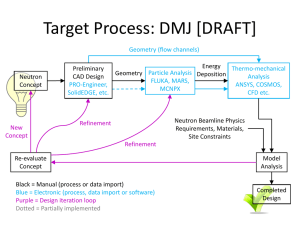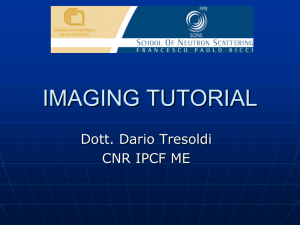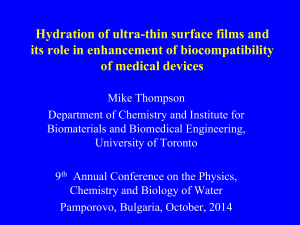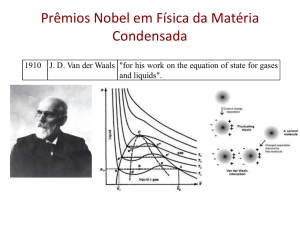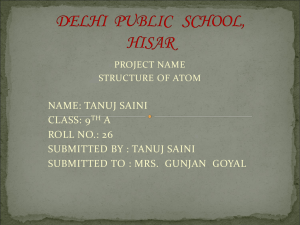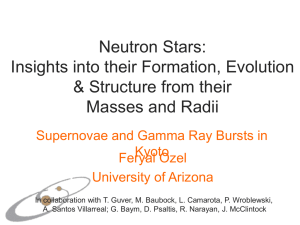Neutrons
advertisement
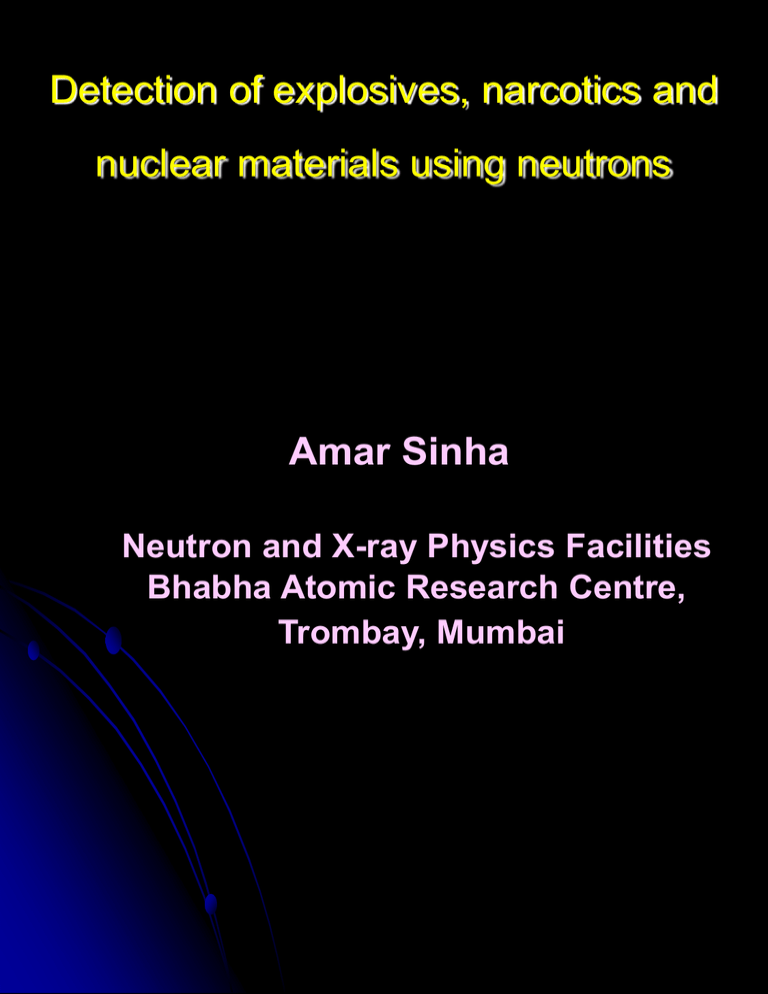
Detection of explosives, narcotics and nuclear materials using neutrons Amar Sinha Neutron and X-ray Physics Facilities Bhabha Atomic Research Centre, Trombay, Mumbai About this talk This talk is about role of nuclear sciences in meeting challenges of counter terrorism This talk is about how the nuclear techniques which have been developed for basic research can be adapted for detection of explosives, narcotics or nuclear materials We will talk on efforts required for developing a system from lab scale to commercial scale This talk will also focus on main constraints in developing such systems –speed, ease of operation, footprint, cost etc Collaborators Mayank Shukla P.S. Sarkar Yogesh Kashyap Tarun Patel Tushar Roy Ashish Agrawal Saroj Bishnoi Ram Kumar Pal Our activities at BARC Neutrons Reactors (CIRUS) -Tomography and Neutron Phase imaging Neutron Generator, D-D and D-T Photoneutron sources Isotopic sources Detector development Applications of neutrons X-ray Imaging Beamline at Indus-II, RRCAT Phase imaging Tomography (Emission and transmission) Medical Imaging Topics Brief description of existing methods Why neutrons? Various Neutron based methods Purnima neutron generator- testing of concept TNA- FNA – PFNA- PFTNA- APINeutrons for nuclear material detection Experiments with Purnima generator on prompt gamma, tagged neutron, backscattering Plan for portable systems What are the various steps in technology development? (a) Mathematical modeling, (b) Modeling of detector responses © Spectrum analysis and deconvolution algorithm (d) Laboratory Testing and their optimization (e) control and data acquisition systems (f) Assembling and testing (g) Development of decision making algorithms (h) Field trials (i) method to make portable systems for smaller vehicle –truck & car (j) method to detect dirty bomb inside cargo (k) method for IED ( l) Indigenous effort to develop API based portable neutron source Work at BARC Limitations of neutron based method Conclusion Conventional methods Transmission X-ray - Generator for passenger baggage to Electron Linac based 9 MeV sources for cargo Single energy dual energy (gross low and high density discrimination) Backscatter – Gamma 3D CT Neutron based techniques Why neutron based? The key to distinguishing explosives from benign material is the use of elemental analysis. X-ray Technique- insufficient Problems with X-ray Conventional technique -X-rays based methods for the detection of explosive materials are chemically blind. They can only determine shapes and densities of objects, leading to false recognition of material that may be physically similar to explosive compounds. A piece of Semtex plastic explosive can be molded to look like a block of cheese or chocolate. Some other technologies can detect only surface of objects or based on close examination of vapour near objects or too cumbersome for mass screening Neutron based techniques It is due to the limitations of conventional techniques to meet such a challenge that other more definitive technique such as neutron based techniques are currently under active development for detecting such contraband materials inside vehicles, marine and air cargo containers They can penetrate the shielding of cargo and to identify the composition of materials- Of particular interest in the detection of conventional explosives are nitrogen, oxygen, carbon, and hydrogen Neutron interrogation offers the possibility of measuring the elemental density of most elements in materials Though not as fast as x-ray screening – but due to their capability to identify the chemical composition lead to lower false alarm rate They are being developed as second line of confirmatory sensor Nuclear Physics behind the technique The physical basis of these techniques is well known to nuclear physicist. What has changed is adoption of such concepts in terms of reconfiguration of neutron sources and detector and methodology for the purpose of explosive detection Physical basis of detection (n, n’) (n,) Emitted gammas are Finger print of element Elemental composition of common substances narcotics, explosives, and chemical weapons Substance Density (g/cm3) %H %C %N %O %C l % Other elements C/ O N/ O Cl/ C Cl/ H Benigns Salt 0.77 0 0 0 0 60 40 0 0 0 0 Sugar 1.2 7 42 0 51 0 0 0.8 0 0 0 Sand 2.3 0 0 0 53 0 47 0 0 0 0 Water 1 11 0 0 89 0 0 0 0 0 0 Wood 0.62 6 47 0 44 0 3 1.1 0 0 0 Petroleum 0.87 14 86 0 0 0 0 0 0 0 0 Cement 2.3 0 0 0 35 0 65 0 0 0 0 PVC 1.32 5 38 0 0 57 0 0 0 1.5 11.5 Polyethylene 0.94 14 86 0 0 0 0 0 0 0 0 Fiberglass 1.7 3 46 0 35 0 16 3 1.3 0 0 Sea water 1.02 10 0 0 88 1.2 0.8 0 0 0 0.03 PETN 1.76 2.4 19 17.7 60.8 0 0 0.3 0.3 0 0 TNT 1.63 2.2 37 18.5 42.3 0 0 0.9 0.4 0 0 Dynamite 1.18 4.2 14.8 18.5 62.4 0 0 0.2 0.3 0 0 C4 1.65 3.6 21.9 34.4 40.1 0 0 0.6 0.9 0 0 Heroin hydrochloride 0.87 6 62.1 3.5 19.7 8.7 0 3.2 0.2 0.1 1.5 Cocaine hydrochloride 0.87 6.5 60.1 4.1 18.8 10.4 0 3.2 0.2 0.2 1.6 Heroin 0.87 6.3 68.2 3.8 21.7 0 0 3.2 0.2 0 0 Cocaine 0.87 6.9 67.3 4.6 21.1 0 0 3.2 0.2 0 0 Explosives Narcotics Substance Density (g/cm3) % H %C %N %O %Cl % Other elements C/O N/O Cl/C Cl/H Chemical_weapons Hydrogen cyanide 3.7 44.5 51. 8 0 0 0 0 0 0 0 Mustard gas 5 30.2 0 0 44.6 20.2 0 0 1.5 8.9 Sarin 7.1 34.3 0 22.9 0 35.7 1.5 0 0 0 Characteristic gamma Signature The technique one chooses is dependent on what you want to detect Incident Neutron energy is important for some inelastic reaction Different detection schemes have been Worked out – (a) based on only capture (b) use Inelastic or both © use imaging to spatially localize the signal (d)other use time of flight Which neutron technique TNA FNA PFTNA NRA ………. PFNA API ………. We focus on a few Methods (a) Thermal Neutron Analysis (TNA): Basic principle of TNA TNA spectrum for Bag with and without small explosive Isotopic source – 252Cf or even Am-Be In fact this technique using 252Cf has been used extensively for interrogating parcels Limitations –mostly qualitative–small parcels – where other background is minimal (b) The main signatures used are derived from detecting the - 4.43 MeV γ-ray from 12C -1.64, 2.31 and 5.11 MeV γ-rays from 14N -6.130 MeV γ-ray from 16O © Pulsed Fast-Thermal Neutron Analysis (PFTNA) Being used for vehicle borne explosive detection UXO characterization landmine detection (d) ELECTRON LINAC BASED NEUTRON SOURCE electron-photon- neutron n e Tantalum Be high energy electrons to produce photons - Photons then produce neutrons through photo-neutron reaction- We have helped Mangalore university design such a source based on microtron (e) Combined Neutron and Gamma-Ray Interrogation Ratio of neutron attenuation to gamma attenuation Ratio of neutron to gamma attenuation Device based on this concept is operational At Brisbane airport for air cargo scanning (f) NEUTRON RESONANCE RADIOGRAPHY Uses energy selective radiography unlike the previous technique which uses white neutron source and requires a variable energy neutron source to extract information. specific mapping of elements based on their resonance properties of their total interaction crosssection Variable energy is produced using d(d,n)3He reaction and energy selection is made by varying production angle Imaging Techniques? The ability to measure precisely elemental concentrations in an inspected object is necessary but not sufficient condition for a successful inspection system. Simple detection of nuclear signature is not enough if the object being inspected has large volume. For large object the information from contraband may be smeared due to signal from surrounding constituents of the cargo If somehow the measurement can be localized inside the volume of cargo, the determined elemental densities will represent the material composition at that very volume element (voxel) and not an average over a larger volume. Improved S/N ratio Two schemes –PFNA and API (g) Pulsed Fast Neutron analysis (PFNA) PFNA –use of pulsed nanosec beam directional monoenergetic beam Producing pulsed Nanosec beam Directional beam -requires large Accelerator -expensive (h) Tagged Neutron (Associated particle Imaging) • It can provide 3D information about any volume by detecting gamma in coincidence with alpha in the DT reaction • It can be used to detect explosives, narcotics etc in cargo • It can be used to detect SNM in CARGO by detecting the fission gamma induced by burst of external neutron • It can be used to detect SNM by use of correlation/coincidence techniques This method has been extensively tested at a Port in Europe under a project named “EURITRAC” EURITRACK –consotorium of 16 European Agencies Explosive detection technique using neutrons We feel API method also called tagged Neutron Method has potential to be used in large cargo/container scanning which is of interest to us. We are coordinating with several agencies in evaluation of such system and for this reason we are evaluating several technologies including API system Fissile material Detection Passive – coincidence -gamma Active interrogation- A variety of signature Neutron in- fission neutron out and delayed – both carry signature Prompt Neutron in – fission gamma out Differential Die away Tagged neutron coincidence Residual fissile material in waste stream Differential Die Away This technique is also used in Hull Monitoring In reprocessing plant to monitor plutonium Dirty Bomb Directional fast neutron Imaging for special Nuclear material (SNM) Delft University of Technology - harbor of Rotterdam The background flux below 10 MeV to be ≈0.01 n/s.cm2 . One kilogram of weapon grade plutonium (WGP) emits 6.104 n/s following a Watt energy spectrum . Simple algebra shows neutron flux from the plutonium becomes over shadowed by the background beyond a distance of about 7 m. Standard scanning methods will not be able to detect such an amount of WGP in a sea container since 7 m is of the order of the dimension of the container. Substantial reduction of the background will be possible by using a fast neutron detector with imaging properties. The background rate within an opening angle corresponding to an angular resolution of 10o for example is reduced by a factor: under the assumption of isotropy of the background. With such a direction sensitive detector the WGP can be detected above the natural background up to a distance of about 70 m. 4 1 2 8 2 t a n 1 0 Fast neutrons lose energy when penetrating hydrocarbon scintillator materials by interactions with protons and carbon nuclei. The recoil proton energy is released as scintillator light and the collision kinematics uniquely defines the scattering angle of the neutron. The proton track itself is too short to be observed. When the scattered neutron experiences a second collision with a proton inside the scintillator the direction of the original incoming track can be determined see figure 1 Directional fast neutron Imaging for special Nuclear material (SNM) Two successive n-p elastic scattering Determine: n interaction positions energy scattered neutron En’ direction scattered neutron energy of the first recoil proton p1 p En E p11 En' n' p2 Determine the incident neutron energy E p s i n E E E n p n ' E n 2 Calculate scatter angle Construct cone Common direction on several cones points to the source Double elastic n-p scattering showing the basic kinematics of event reconstruction. If the full neutron energy is measured, the incident neutron direction is restricted to the mantle of a cone and an “event circle” can be drawn : Schematic of the source-imaging fast-neutron detector. Reactions of two incoming neutrons are shown (tracks in green and blue). The small arrows show recoiling protons (in red). For simplicity only one light sensor (PMT) is indicated. Working on Various steps in technology development? (a) Simulation -optimize parameter (b) Laboratory Testing and their optimization (c) Modeling of detector responses (d) Spectrum analysis and deconvolution algorithm (e) control and data acquisition systems (f) Assembling and testing (g) Development of decision making algorithms _neural network, Fuzzy Logic (h) Field trials (i) method to make portable systems for smaller vehicle –truck & car (j) method to detect nuclear material in cargo ( k) Indigenous effort to develop portable neutron source Neutron Generator at Purnima, Ion BARC Source Faraday Cup Tritium Target Dome Beam Steerer 400 kV DC Power Supply BPM Accelera ting Column Farad Tritiu ay m Cup Target F Beam Steer BPMer Ion source Dome High Accelerat Ting Tube M P Voltage Power Supply Turbo Molecul ar Pump Photograph of the Purnima neutron generator •Cockcroft-Walton voltage multiplier Schematic of the Purnima Neutron Generator Basic facility for testing before field application Status This generator is running in both D-D and D-T mode Safety committee has permitted us to operate it at 107 n/s in D-T and 3x 107 n/s in D-D mode However shortly we are going to take a trial run in D-T mode upto 1010 n/s Experiments on PGNA Spectrum of Urea showing H and N capture lines -Top curve with urea -bottom without urea Graph of the Signal and background data in terms of channel versus counts. The Hydrogen peak at 2.22 MeV and the nitrogen photopeak at 10.829MeV are very clearly visible. Nitrogen single escape peak is also distinguishable. The data collection time was 1800 seconds. Urea (CO(NH2)2) : Molecular weight: 60.06 gm, Density: 1.33gm /cc: Composition: H—6.71%, C – 20%, N – 46.65% and O – 26.64% Sample: Salt (NaCl) The main aim to carry out the detection chlorine (Cl) capture lines in salt is due to fact that chlorine based compounds form part of narcotics. Since Cl has more neutron capture cross-section (43b) than Na the capture gammas of Cl are much more detectable than Na. In a data collection time of 1200 seconds we could detect 4 Chlorine photo-peaks and one of their escape peaks. Left graph shows the Chlorine peaks (labeled in MeV energy): Cl-6.619MeV and Cl – 6.11 MeV along with its single escape peak Cl’ – 5.599MeV and double escape peak Cl’’ – 5.08MeV. The right hand side graph shows the other Cl lines, 1.16MeV and 1.95MeV. Prompt inelastic gamma D-T neutron Graphite (6-8kg)sample was irradiated for the detection of theprompt gamma 4.439MeV from carbon element. We have observed the 4.439 as well as its first escape peak Aquisition Time=20 min ...Background ...Graphite 5 10 Counts C(3928-SE) C-4439 4 10 100 200 300 400 Channel Number Similarly experiments with urea and water for nitrogen and oxygen detection have been done. Developing Tagged Neutron (Associated particle Imaging) API method diagram In the d + t reaction a neutron with energy of 14 MeV and an alpha particle with energy of 3.5 MeV are emitted “back-to-back” DT (En=14 МeV) Eα = 3.5 MeV Time-of-flight for 14 МeV neutron: 1 ns => 5.2 cm Ability for 3Dimaging: elemental analysis + direction and depth Sufficient improvement for ratio effect/background Experiments on developing neutron tagging method D+T – n+ It is a challenge to discriminate D+D – n+He-3 D+D –t+p Experiments on tagging in collaboration with Italian Researchers Simulated experiment on illicit material detection using tagged neutron technique Fig. 4 Gamma spectrum and time domain counting for tagged neutron analysis Detectors We are conducting experiments with NaI (3”, 5”). BGO, LaBr to optimize the detector configuration for a workable detection system for cargo, vehicle. We are also developing suitable electronics and data acquisition system for this work. Development of simulation tools Simulation Model 50 X 50 X50 cm3 VARYING DENSITY OF ORGANIC / METALLIC MATRIX Cargo 250 (W), 250 (H), 100 (L) TOP DETECTOR RESPONSE AS A FUNCTION OF TIME Tagging Interval signal to noise ratio increases in 30-50ns time interval indicating presence of an anomaly FRONT DETCTOR RESPONSE AS A FUNCTION OF TIME Tagging interval Case study Varying explosive quantity Varying explosive location Varying density of embedded matrix Different types of material such as Nylon, Cocaine etc 200kg explosive in 0.2gm/cc N14 C12 sum of counts of all top detector in 27-45ns N14 O16 Front Detector C12 O16 50kg explosive in 0.2gm/cc 25kg explosive in 0.2gm/cc matrix 200kg in 0.5gm/cc matrix 50Kg in 0.5gm/cc matrix 25 kg explosive in 0.5gm/cc matrix located near to top detectors Location of detectors with respect to explosive plays a important role. Double sided scanning may help to improve the possibility of detection of explosives Cocaine in a organic matrix of 0.5gm/cc Organic matrix has self background which may be sufficient to shield these materials if put in high density matrix Need additional tool or information to distinguish these from organic materials Detection of explosive with Tagged Neutron method will be dependent of several factors Quantity of explosive Matrix density Type of matrix Location of explosive in the cargo Nature of surrounding matrix Nature of background etc Study of neutron backscattering method for landmine detection What are its potentials and limitations What kind of system will work in specific condition Such studies have been carried out by other researchers for specific experimental system and different source and experimental condition Simulation geometry Neutron detector+ shielding (2.5x2.5x15 cm3) Standoff distance (2cm) TNT (C7H5N3O6) Soil DD/DT neutron source Mine depth (5cm 20cm) PMA2-mine at the depth 5cm Simulation for SNM Polythene graphite Schematic of SNM monitoring device Plot of reaction rates as a function of Time with and without fissile material (A drum containing 0.5% of fissile material in 13.3 kg of actinide content) Further data analysis consists in decomposition of energy spectra of γ-rays collected for every “voxel” of the inspected volume, into contributions from various chemical elements. Response function of individual elements Multivariate calibration • Often want to estimate a property based on a multivariate response • Typical cases • Estimate analytic concentrations (y) from spectra (X) • Finding Elemental composition (y) from fluorescence spectrum (X) • Want solution of form Xb = y + e • Problem: how to estimate b? Partial least Square regression PLS is related to PCR ( Principle component Regresion) and MLR (Multi Linear Regression) PCR captures maximum variance in X MLR achieves maximum correlation between X and Y PLS tries to do both by maximizing covariance between X and Y X is a matrix containing spectrum of several samples with known compositions Y is the matrix of concentrations of various elements present in the modeled samples then their relation can be written Let Y = XB + F (Where F is the matrix of residual) (1) The PLSR model can be considered as consisting of three relations X = TP’ + E, Y = UQ’ + F, and U = BT Where P,Q are loading matrixes of X,Y. T,U are score matrix of X,Y and E,F are matrix of residuals. B is matrix relating X block scores to Y block scores. When all the scores are calculated the concentration of unknown sample can be obtained from the following relation Y = BTQ’ + F Calibration and crossvalidation Sample ( wt % )H ( wt % ) C ( wt % ) N ( wt % ) O S1 5 25 30 40 S2 6 18 35 41 S3 5 20 28 47 S4 8 28 20 44 S5 2 30 18 50 S6 3 25 22 50 S7 4 18 25 53 S8 6 21 30 43 S9 4 15 24 57 S10 3 23 33 41 Application of PLS technique in quantitative determination of explosive elements S7 S8 S9 S10 4 6 4 3 Predicted 3.99 5.992 4.47 2.61 Actual 18 21 15 23 Predicted 17.49 20.90 14.28 23.08 Actual 25 30 24 23 Predicted 25.75 30.16 25.09 32.50 53 43 57 41 52.53 43.46 55.99 41.51 H Actual C N O Actual Predicted Artificial Neural Network (ANN) for Explosive Detection Neural network architecture Neuron Model Transfer functions ANN model for explosive detection Feed-forward network with backpropagation algorithm Two stage network 10 element vector input (C, H, N, O, Cl, C/N, C/O, N/O, Cl/C, Cl/H) 29 patterns (explosives/narcotics) 35 neurons in the hidden layer Tan-sigmoid transfer function Tan-sigmoid transfer function Feed-Forward Network Training data Input Vector Element Paramet er 1 C 2 H 3 N 4 O 5 Cl 6 C/O 7 C/N 8 N/O 9 Cl/C 10 Cl/H Training Performance Recall test values Input: Original input values used in training Simulated Input for: RDX: [16.22 2.72 37.84 43.22 0 0.42865 0.87552 0.37529 0 0 ] Cocaine: [67.3 6.9 4.6 21.1 0 14.63 0.2 3.2 0 0 ] Recall test values with 5% error Input: 5% random error added to original input values used in training Simulated Input for: RDX: [15.855 2.6772 37.75 44.995 0 0.44322 0.91611 0.37401 0 0 ] Cocaine: [70.514 6.8679 4.5525 21.77 0 15.223 0.19993 3.12 0 0 ] Limitations The method is slower compared to X-ray (seconds vs minutes) Can be used as confirmatory sensor Still much work remains to be done to make it commercial Conclusions We have reviewed various methods of explosive detection The necessary steps in developing such systems have been highlighted We have described our work at BARC for this development We have brought out multidisciplinary nature of this work We have also pointed out the limitations of the technique
